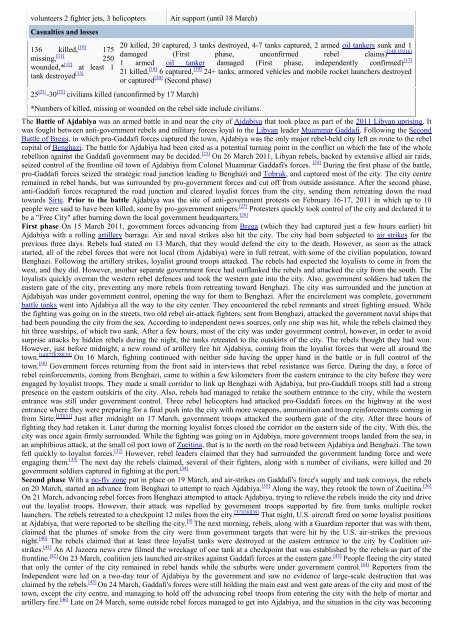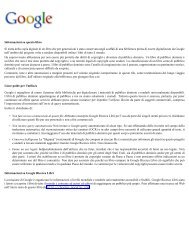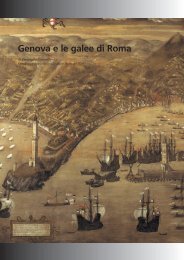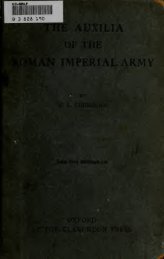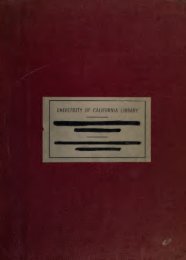Libyan Civil War Libyan Civil War - Libreria Militare Ares
Libyan Civil War Libyan Civil War - Libreria Militare Ares
Libyan Civil War Libyan Civil War - Libreria Militare Ares
You also want an ePaper? Increase the reach of your titles
YUMPU automatically turns print PDFs into web optimized ePapers that Google loves.
volunteers 2 fighter jets, 3 helicopters<br />
Casualties and losses<br />
Air support (until 18 March)<br />
136 killed, [10] 20 killed, 20 captured, 3 tanks destroyed, 4-7 tanks captured, 2 armed oil tankers sunk and 1<br />
175<br />
missing, [11] damaged (First phase, unconfirmed rebel claims) [14][15][16]<br />
250<br />
wounded,* [12] 1 armed oil tanker damaged (First phase, independently confirmed) [17]<br />
at least 1<br />
tank destroyed [13] 21 killed, [18] 6 captured, [19] 24+ tanks, armored vehicles and mobile rocket launchers destroyed<br />
or captured [20] (Second phase)<br />
25 [21] -30 [22] civilians killed (unconfirmed by 17 March)<br />
*Numbers of killed, missing or wounded on the rebel side include civilians.<br />
The Battle of Ajdabiya was an armed battle in and near the city of Ajdabiya that took place as part of the 2011 <strong>Libyan</strong> uprising. It<br />
was fought between anti-government rebels and military forces loyal to the <strong>Libyan</strong> leader Muammar Gaddafi. Following the Second<br />
Battle of Brega, in which pro-Gaddafi forces captured the town, Ajdabiya was the only major rebel-held city left en route to the rebel<br />
capital of Benghazi. The battle for Ajdabiya had been cited as a potential turning point in the conflict on which the fate of the whole<br />
rebellion against the Gaddafi government may be decided. [23] On 26 March 2011, <strong>Libyan</strong> rebels, backed by extensive allied air raids,<br />
seized control of the frontline oil town of Ajdabiya from Colonel Muammar Gaddafi's forces. [24] During the first phase of the battle,<br />
pro-Gaddafi forces seized the strategic road junction leading to Benghazi and Tobruk, and captured most of the city. The city centre<br />
remained in rebel hands, but was surrounded by pro-government forces and cut off from outside assistance. After the second phase,<br />
anti-Gaddafi forces recaptured the road junction and cleared loyalist forces from the city, sending them retreating down the road<br />
towards Sirte. Prior to the battle Ajdabiya was the site of anti-government protests on February 16-17, 2011 in which up to 10<br />
people were said to have been killed, some by pro-government snipers. [25] Protesters quickly took control of the city and declared it to<br />
be a "Free City" after burning down the local government headquarters. [26]<br />
First phase On 15 March 2011, government forces advancing from Brega (which they had captured just a few hours earlier) hit<br />
Ajdabiya with a rolling artillery barrage. Air and naval strikes also hit the city. The city had been subjected to air strikes for the<br />
previous three days. Rebels had stated on 13 March, that they would defend the city to the death. However, as soon as the attack<br />
started, all of the rebel forces that were not local (from Ajdabiya) were in full retreat, with some of the civilian population, toward<br />
Benghazi. Following the artillery strikes, loyalist ground troops attacked. The rebels had expected the loyalists to come in from the<br />
west, and they did. However, another separate government force had outflanked the rebels and attacked the city from the south. The<br />
loyalists quickly overran the western rebel defences and took the western gate into the city. Also, government soldiers had taken the<br />
eastern gate of the city, preventing any more rebels from retreating toward Benghazi. The city was surrounded and the junction at<br />
Ajdabiyah was under government control, opening the way for them to Benghazi. After the encirclement was complete, government<br />
battle tanks went into Ajdabiya all the way to the city center. They encountered the rebel remnants and street fighting ensued. While<br />
the fighting was going on in the streets, two old rebel air-attack fighters, sent from Benghazi, attacked the government naval ships that<br />
had been pounding the city from the sea. According to independent news sources, only one ship was hit, while the rebels claimed they<br />
hit three warships, of which two sank. After a few hours, most of the city was under government control, however, in order to avoid<br />
surprise attacks by hidden rebels during the night, the tanks retreated to the outskirts of the city. The rebels thought they had won.<br />
However, just before midnight, a new round of artillery fire hit Ajdabiya, coming from the loyalist forces that were all around the<br />
town. [14][27][28][29] On 16 March, fighting continued with neither side having the upper hand in the battle or in full control of the<br />
town. [30] Government forces returning from the front said in interviews that rebel resistance was fierce. During the day, a force of<br />
rebel reinforcements, coming from Benghazi, came to within a few kilometers from the eastern entrance to the city before they were<br />
engaged by loyalist troops. They made a small corridor to link up Benghazi with Ajdabiya, but pro-Gaddafi troops still had a strong<br />
presence on the eastern outskirts of the city. Also, rebels had managed to retake the southern entrance to the city, while the western<br />
entrance was still under government control. Three rebel helicopters had attacked pro-Gaddafi forces on the highway at the west<br />
entrance where they were preparing for a final push into the city with more weapons, ammunition and troop reinforcements coming in<br />
from Sirte. [13][31] Just after midnight on 17 March, government troops attacked the southern gate of the city. After three hours of<br />
fighting they had retaken it. Later during the morning loyalist forces closed the corridor on the eastern side of the city. With this, the<br />
city was once again firmly surrounded. While the fighting was going on in Ajdabiya, more government troops landed from the sea, in<br />
an amphibious attack, at the small oil port town of Zueitina, that is to the north on the road between Ajdabiya and Benghazi. The town<br />
fell quickly to loyalist forces. [32] However, rebel leaders claimed that they had surrounded the government landing force and were<br />
engaging them. [33] The next day the rebels claimed, several of their fighters, along with a number of civilians, were killed and 20<br />
government soldiers captured in fighting at the port. [34]<br />
Second phase With a no-fly zone put in place on 19 March, and air-strikes on Gaddafi's force's supply and tank convoys, the rebels<br />
on 20 March, started an advance from Benghazi to attempt to reach Ajdabiya. [35] Along the way, they retook the town of Zueitina. [36]<br />
On 21 March, advancing rebel forces from Benghazi attempted to attack Ajdabiya, trying to relieve the rebels inside the city and drive<br />
out the loyalist troops. However, their attack was repelled by government troops supported by fire from tanks multiple rocket<br />
launchers. The rebels retreated to a checkpoint 12 miles from the city. [37][38][39] That night, U.S. aircraft fired on some loyalist positions<br />
at Ajdabiya, that were reported to be shelling the city. [9] The next morning, rebels, along with a Guardian reporter that was with them,<br />
claimed that the plumes of smoke from the city were from government targets that were hit by the U.S. air-strikes the previous<br />
night. [40] The rebels claimed that at least three loyalist tanks were destroyed at the eastern entrance to the city by Coalition airstrikes.<br />
[41] An Al Jazeera news crew filmed the wreckage of one tank at a checkpoint that was established by the rebels as part of the<br />
frontline. [42] On 23 March, coalition jets launched air-strikes against Gaddafi forces at the eastern gate. [43] People fleeing the city stated<br />
that only the center of the city remained in rebel hands while the suburbs were under government control. [44] Reporters from the<br />
Independent were led on a two-day tour of Ajdabiya by the government and saw no evidence of large-scale destruction that was<br />
claimed by the rebels. [45] On 24 March, Gaddafi's forces were still holding the main east and west gate areas of the city and most of the<br />
town, except the city centre, and managing to hold off the advancing rebel troops from entering the city with the help of mortar and<br />
artillery fire. [46] Late on 24 March, some outside rebel forces managed to get into Ajdabiya, and the situation in the city was becoming


